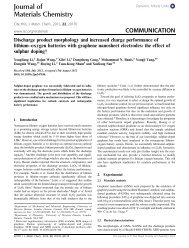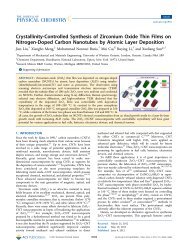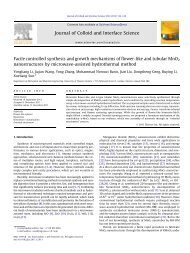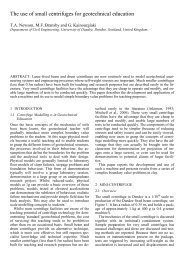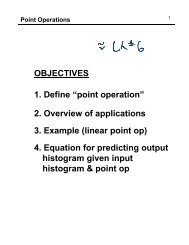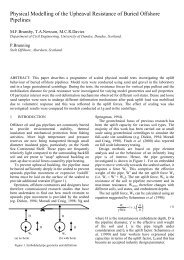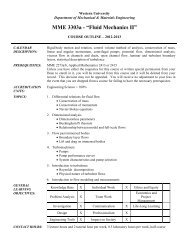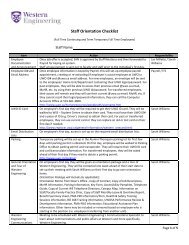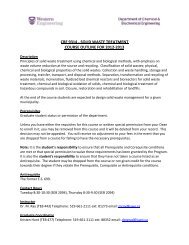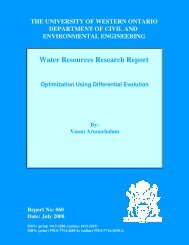(TMS) or Time Dial - Western Engineering - University of Western ...
(TMS) or Time Dial - Western Engineering - University of Western ...
(TMS) or Time Dial - Western Engineering - University of Western ...
You also want an ePaper? Increase the reach of your titles
YUMPU automatically turns print PDFs into web optimized ePapers that Google loves.
The amperes at 13 kV side <strong>of</strong> Transf<strong>or</strong>mer is calculated in <strong>or</strong>der to show the Co<strong>or</strong>dination on same voltage level , so the 125E<br />
fuse in the 115 kV circuit is plotted at<br />
115/13.09=8.79 times the manufacturer's curves.<br />
Thus, the 600 sec minimum-melt current <strong>of</strong> 250 A becomes 250 x 8.79 = 2196 A f<strong>or</strong> balanced currents.<br />
Whereas phase-to-phase faults on the 13 kV side are 0.866 <strong>of</strong> the three phase fault value, the current in one phase on the primary is<br />
the same as the three-phase fault value. However, the primary fuse sees only 0.577 <strong>of</strong> the secondary one-per-unit current f<strong>or</strong> 13 kV<br />
phase-to-ground faults. The transf<strong>or</strong>mer through-fault over current limit curve is plotted as shown in figure# 4 the transf<strong>or</strong>mer is<br />
protected satisfact<strong>or</strong>ily against thermal damage.<br />
9.2 Fuse<br />
The 65T and 100T fuses selected on the basis <strong>of</strong> the loads served from the taps are shown plotted in Figure 5 from the<br />
manufacturer's curves. The left curve is minimum melt, and the right maximum clearing.<br />
The maximum load through the recloser is Max Load = 230 A.<br />
9.3 Recloser.<br />
A recloser was selected. with a minimum trip rating <strong>of</strong> 560 A phase, slightly m<strong>or</strong>e than twice the load needed to override cold load<br />
with a safety fact<strong>or</strong>. The time characteristics units are plotted f<strong>or</strong> the timed and the instantaneous operations. In this term paper I<br />
Simulated Recloser with the Help <strong>of</strong> E.I O.C relay as the Actual reloser is not available in this limited licensed version <strong>of</strong><br />
ETAP.<br />
To provide this instantaneous tripping, phase can be applied to breakers to supplement the time units. Reclosers have either a fast <strong>or</strong><br />
slow time-current characteristic, <strong>of</strong> which only one at a time can be used. Several attempts can be made, usually 1-3. The particular<br />
number and sequence is based on many local fact<strong>or</strong>s and experiences.<br />
9.4 Current Transf<strong>or</strong>mer Selection.<br />
The maximum load through the breaker and relays at the 13 kV bus is 330 A. Thus, the CT ratio <strong>of</strong> 400:5 will give a secondary<br />
current <strong>of</strong> 330/80 = 4.13A.<br />
9.5 Over current Relay<br />
Extremely inverse time over current relays provide good co<strong>or</strong>dination with the fuses and the recloser. Selecting tap 9 provides a<br />
phase relay pickup <strong>of</strong> 9 x 80 = 720 A, just over twice the maximum load needed to override a cold load.<br />
9.6 Fuse-saving<br />
This is used to avoid fuse operations f<strong>or</strong> transient faults and, thereby, avoid long outages f<strong>or</strong> crews to replace them. This is<br />
accomplished by a second instantaneous unit set to overreach the fuse and, in the hope to clear transient faults bef<strong>or</strong>e the fuse<br />
can operate. An instantaneous recloser is attempted and, if successful, service is rest<strong>or</strong>ed. The instantaneous unit is locked out,<br />
thereby permitting the fuse to clear a continuing fault. An industry survey by the IEEE showed that 81% use this f<strong>or</strong> phase faults and<br />
61% f<strong>or</strong> ground faults.<br />
Thus, f<strong>or</strong> fuse-saving at the breaker, as in Figure 4, the instantaneous units could be set to operate f<strong>or</strong> fault 2, but not f<strong>or</strong> fault 1, <strong>or</strong> at<br />
5374 A phase, However, it is imp<strong>or</strong>tant that the instantaneous unit and breaker clear faults bef<strong>or</strong>e the fuse is damaged (minimum<br />
melt) <strong>or</strong> blown. Figure 5 shows that the 100T fuse will be damaged at about 5000 A after about 0.03 sec (1.8 cycles at 60 Hz). Thus,<br />
the fuse will blow bef<strong>or</strong>e the breaker opens; theref<strong>or</strong>e, fuse-saving is not applicable at the breaker.<br />
Fuse-saving is applicable at the recloser when operating on its fast <strong>or</strong> instantaneous curves. F<strong>or</strong> faults on the laterals beyond Bus faults<br />
(21,27, <strong>or</strong> 32), the` recloser will trip and recloser once <strong>or</strong> twice as programmed. If the fault is transient and cleared, service will be<br />
rest<strong>or</strong>ed without a fuse operation. after this, the recloser operates on its slow curves, and the fault is cleared y the proper fuse on the<br />
laterals <strong>or</strong> by the recloser f<strong>or</strong> faults on the feeder.<br />
8





